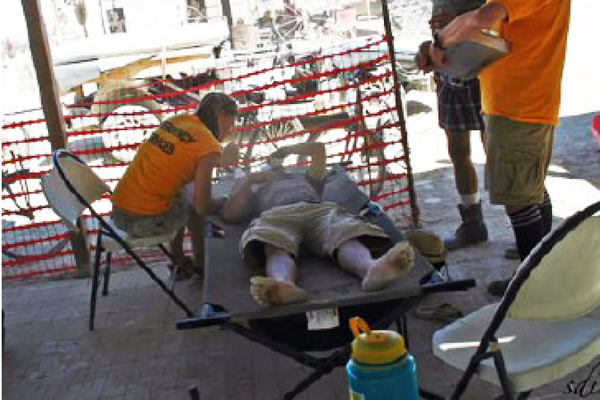Few
events in the world compare to Burning Man, the 50,000-person arts
festival that takes place each summer in northern Nevada. During the
week leading up to Labor Day, the remote Black Rock Desert is
transformed into a spectacle of color, sound, art and performance.
Perhaps more remarkable is that the Black Rock Desert is an
oftentimes-hostile environment. Temperature extremes of 100+ degree days
and near-freezing nights, dust storms that may rage up to 70 mph, and
the caustic alkali dust that lines the ancient dry lake bed where the
festival is held, are just some of the challenges visitors face. Between
the natural environment of the desert and the festival’s revelry,
accidents, injuries and illnesses are inevitable.
Coordinating
Burning Man’s emergency medical response is the Black Rock City
Emergency Services Department (BRCESD): a mostly-volunteer organization
of “Burners” with a wide variety of backgrounds in emergency management
and medicine. There are two main phases to ESD’s medical mission: the
event itself and its setup and cleanup (known as Pre/Post). The Event
Operations phase is characterized by bringing modern medical resources
to an austere environment, while Pre/Post Operations more closely
resemble a traditional wilderness approach.

ESD EVENT OPERATIONS
During
the week-long event, ESD facilitates not only EMS and clinic-based
medical support for Burning Man, but also Fire/Rescue and Mental Health
services. Additionally, ESD builds the technical infrastructure to
support radio and paging communications, and provides on-site dispatch
services. Hundreds of healthcare providers from across the world
volunteer their time and experience with Black Rock City Emergency
Services. Burning Man contracts with Humboldt General Hospital (HGH) to
provide advanced life support ambulances and clinical care, and the
volunteers of ESD provide basic life support response.
ESD brings modern emergency healthcare to a unique and austere
environment, with three clinics forming the foundation of on-site
medical care and a fleet of response units. And HGH’s 2,000 square-foot,
32-bed inflatable disaster medical tent is equipt with IV therapy,
x-ray, blood labs, ECG, suture rooms and more. Due to the on-site
facilities during the event, only the most critical cases are evacuated
via ground or air ambulance to Reno. ESD Pre/Post-Event Medical
Operations Year-round planning and several months of on-site work are
required to prepare the desert for Burning Man. The event
infrastructure’s physical set up period begins in July and the last
crews don’t leave until early October after ensuring the event has
abided by its Leave No Trace principle. The crews who build Burning
Man’s infrastructure live and work in the same space for weeks on end.
They share quarters, take meals together and spend their free time in
each other’s company. The result is a unique culture and camaraderie
that motivates the entire team in the face of less-than-ideal conditions
brought about by working in the desert. During these times, there are
no advanced medical resources: there is no on-site facility staffed with
MDs and RNs and stocked with modern technology like there is during the
event. It’s a 90-minute drive to the closest clinic and the closest
hospital is two hours away in Reno. A small group of hand-picked ESD
healthcare providers, familiar with the unique culture of Burning Man,
deploy alongside the organization’s work crews to provide medical
support. They live among them, treating injuries and illnesses,
advocating for worksite safety and promoting public health.
Temperature extremes of 100+ degree days
and near-freezing nights, dust storms that may rage up to 70 mph, and
the caustic alkali dust that lines the ancient dry lake bed where the
festival is held, are just some of the challenges visitors face.